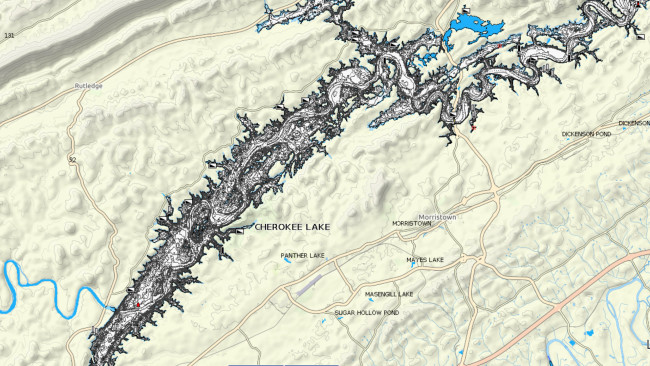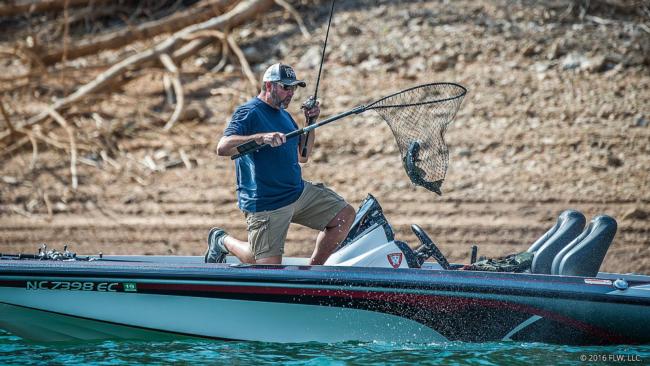2019 Cherokee Lake Preview
The lowdown on the fifth stop of the FLW Tour

Jefferson City, Tenn.
April 11-14, 2019
Hosted by the Economic Development Alliance, Jefferson County

About the fishery
Nestled in the hills of east Tennessee, Cherokee Lake is a TVA impoundment on the Holston River, and it sits roughly between Norris Lake (to the northwest) and Douglas Lake (to the southeast). Depending on the water level, Cherokee has about 400 miles of shoreline and 28,780 surface acres, making it plenty big for a tournament like an FLW Tour event. In a normal year, Cherokee will fluctuate about 30 feet between winter pool and spring flooding, which is a lot, but nothing out of the ordinary for the average East Tennessee reservoir.
Built in the 1940s, Cherokee doesn’t have much wood cover left in it, but there are some fishable bushes and laydowns depending on the water level. There are also a fair number of docks, though the lake isn’t nearly as heavily populated as a place like Norman, or perhaps even Smith Lake. Due to the fluctuating water, there’s no grass at all, but there are miles of pockets, humps, points and islands with about every kind of rock and gravel you could dream of. Because it’s a highland impoundment, the water clarity is usually excellent.
Filled with shad, alewives and also the usual crappie, bream and crawfish, Cherokee has a solid forage base for the gamefish. Though the lake has walleye, big stripers and even paddlefish, the main attraction at the fishery is bass. Smallmouths, largemouths and spotted bass all call the lake home, and which species plays the best on derby day will be fascinating to follow.
Last time
The only FLW history to draw from on Cherokee is from T-H Marine Bass Fishing League (BFL) derbies, but even that is a little scattered. It’s been a long time since a BFL has hit Cherokee at the same time as the Tour will. One of the closest comparisons might be a 2008 Volunteer Division event held in early May and won on a finesse worm by Charlie Lane, but the best is probably a mid-April event from 2001 that Kevin Powers won flipping docks. Any way you slice it, the pros will be creating some new history on Cherokee this week, and past results aren’t likely to be an accurate guide, as they so often are on more trafficked tournament fisheries.

What to expect this time
Given fairly stable conditions, Tour pros should see a pretty good mix of prespawn and spawning fish with water low on the banks. The really interesting thing to watch will be the species mix, as Cherokee has a population of smallmouths good enough to win on, but there are plenty of largemouths as well.
“It’ll probably be a mix,” says FLW Tour pro Chris Whitson of Louisville, Tenn. “A guy could go and catch 15 pounds of smallmouths four days in a row – it’s definitely doable – but a guy cannot just fish largemouth. They may have a 20-pound bag, but they’ll run out of fish in a four-day tournament.”
FLW Tour pro Jason Abram is even more inclined to give the edge to smallmouths.
“The smallmouth population in Cherokee is pretty strong,” Abram explains. “It’s very possible that they could be bedding, although the TVA started dropping the water last week, and that could hold them off. In my opinion, the majority of the anglers in the top 50 will likely be fishing for smallmouth.”
Like a lot of lakes, the lower end is clearer and has more smallmouths, and the upper end and the creeks have more water color and more largemouths. If someone does manage to win on a combo instead of just smallmouths, that could mean they’re fishing day four a long way from where they started on day one.
Though the lake has really good populations of both smallmouths and largemouths, it isn’t known for massive specimens. Both species might produce a 5-pounder or two during the tournament, but the real deal will be catching fish that are incrementally better to cull up past 16 or so pounds. With that in mind, a winning weight of somewhere around 64 pounds seems reasonable to Whitson, with a decent chance to bump it up if someone has a big largemouth day and can back it up with some quality smallmouths.

Baits and techniques
With two species in the crosshairs of pros and fish on and off beds, there is going to be a pretty good buffet of tactics to choose from. For the smallmouths, a lot of finesse tactics will play, as will sight-fishing. Jerkbaits and swimbaits could also account for a lot of prespawn fish.
On the largemouth side of things, look for jigs, spinnerbaits, crankbaits and finesse tactics to catch fish.
If you’re looking for some real east Tennessee stuff to play, stay tuned – there’s a decent chance a flat-sided crank or a wake bait will put some fish in the boat this week.
3 Critical factors
1. Weather – Clear water and the presence of both prespawn and spawning fish mean the weather is paramount. From how fast the bass hit the beds to the development of a moving-bait bite in the wind or mudlines, keeping an eye on the overall weather and the daily weather will be key.
2. Spawning smallmouths – The smallmouths in Cherokee typically spawn before the largemouths, and there are a lot of spawn-time experts in the Tour field. The odds are good that the winner weighs a lot of spawning brown fish, even if they don’t catch ‘em sight-fishing.
3. Water level – Locals say the water level on Cherokee can really impact the fishing. Depending on if it is falling or rising, new bites could easily develop during the tournament from day to day.

Pros to watch
In the spring on clear-water lakes, it’s almost a given that folks like Scott Martin and Bryan Thrift will do well, and with spawning fish in play, you’d be wise to keep an eye on John Cox. Because of the smallmouths, expect folks like Ron Nelson, Austin Felix, Cody Hahner, Matt Stefan and Josh Douglas to have an edge as well. There are also quite a few locals in the field, from Abram and Whitson to Rex Huff, Derrick Snavely, Bob Morin and Tim Malone, in addition to Brant Grimm and Corey Neece, who both happen to have BFL wins on Cherokee.